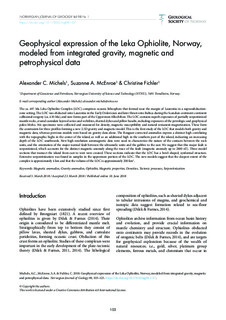| dc.contributor.author | Michels, Alexander | |
| dc.contributor.author | McEnroe, Suzanne | |
| dc.contributor.author | Fichler, Christine | |
| dc.date.accessioned | 2019-02-26T12:25:09Z | |
| dc.date.available | 2019-02-26T12:25:09Z | |
| dc.date.created | 2018-08-08T12:05:21Z | |
| dc.date.issued | 2018 | |
| dc.identifier.citation | Norsk Geologisk Tidsskrift. 2018, 98 (1), 103-125. | nb_NO |
| dc.identifier.issn | 0029-196X | |
| dc.identifier.uri | http://hdl.handle.net/11250/2587464 | |
| dc.description.abstract | The ca. 497 Ma Leka Ophiolite Complex (LOC) comprises oceanic lithosphere that formed near the margin of Laurentia in a suprasubductionzone setting. The LOC was obducted onto Laurentia in the Early Ordovician and later thrust onto Baltica during the Scandian continent-continent collisional orogeny (ca. 430 Ma), and now forms part of the Uppermost Allochthon. The LOC contains superb exposures of partially serpentinized mantle rocks, crustal cumulate layered series and wehrlites, sheeted dykes and pillow basalts, including exposures of the petrologic and geophysical paleo-Moho. 564 specimens were collected and measured for density, magnetic susceptibility and natural remanent magnetization. These form the constraints for three profiles forming a new 2.5D gravity and magnetic model. This is the first study of the LOC that models both gravity and magnetic data, whereas previous models were based on gravity data alone. The Bouguer-corrected anomalies express a distinct high correlating with the topographic highs in the center of the island, as well as an additional high in the southern part of the island, indicating an increasing depth of the LOC southwards. New high-resolution aeromagnetic data were used to characterize the nature of the contacts between the rock units, and the orientation of the major normal fault between the ultramafic units and the gabbro to the east. We suggest that this major fault is serpentinized, which accounts for the distinct magnetic anomaly along the trace of the fault (magnetic anomaly up to 2800 nT). Three model sections that transect the island from east to west were created. These sections indicate that the LOC has a bowl-shaped, synformal structure. Extensive serpentinization was found in samples in the uppermost portion of the LOC. The new models suggest that the deepest extent of the complex is approximately 4 km and that the volume of the LOC is approximately 200 km3. | nb_NO |
| dc.language.iso | eng | nb_NO |
| dc.publisher | Geological Society of Norway | nb_NO |
| dc.rights | Navngivelse 4.0 Internasjonal | * |
| dc.rights.uri | http://creativecommons.org/licenses/by/4.0/deed.no | * |
| dc.title | Geophysical expression of the Leka Ophiolite, Norway modeled from integrated gravity, magnetic and petrophysical data | nb_NO |
| dc.type | Journal article | nb_NO |
| dc.type | Peer reviewed | nb_NO |
| dc.description.version | publishedVersion | nb_NO |
| dc.source.pagenumber | 103-125 | nb_NO |
| dc.source.volume | 98 | nb_NO |
| dc.source.journal | Norsk Geologisk Tidsskrift | nb_NO |
| dc.source.issue | 1 | nb_NO |
| dc.identifier.doi | 10.17850/njg98-1-07 | |
| dc.identifier.cristin | 1600410 | |
| dc.description.localcode | ©2018 Copyright the authors. This work is licensed under a Creative Commons Attribution 4.0 International License. | nb_NO |
| cristin.unitcode | 194,64,90,0 | |
| cristin.unitname | Institutt for geovitenskap og petroleum | |
| cristin.ispublished | true | |
| cristin.fulltext | original | |
| cristin.qualitycode | 1 | |

